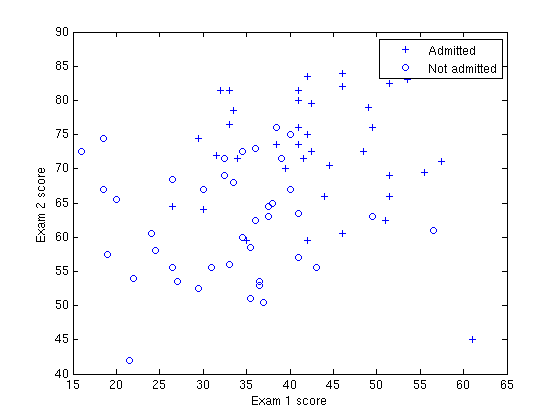Exercise: Logistic Regression and Newton's Method
In this exercise, you will use Newton's Method to implement logistic regression on a classification problem.
Data
To begin, download ex4Data.zip and extract the files from the zip file.
For this exercise, suppose that a high school has a dataset representing 40
students who were admitted to college and 40 students who were not
admitted. Each
![]() training example contains a student's score
on two standardized exams and a label of whether the student was admitted.
training example contains a student's score
on two standardized exams and a label of whether the student was admitted.
Your task is to build a binary classification model that estimates college admission chances based on a student's scores on two exams. In your training data,
a. The first column of your x array represents all Test 1 scores, and the second column represents all Test 2 scores.
b. The y vector uses '1' to label a student who was admitted and '0' to label a student who was not admitted.
Plot the data
Load the data for the training examples into your program and add
the ![]() intercept term into your x matrix.
intercept term into your x matrix.
Before beginning Newton's Method, we will first plot the data using different symbols to represent the two classes. In Matlab/Octave, you can separate the positive class and the negative class using the find command:
% find returns the indices of the % rows meeting the specified condition pos = find(y == 1); neg = find(y == 0); % Assume the features are in the 2nd and 3rd % columns of x plot(x(pos, 2), x(pos,3), '+'); hold on plot(x(neg, 2), x(neg, 3), 'o')
Your plot should look like the following:

Newton's Method
Recall that in logistic regression, the hypothesis function is
 |
|||
In our example, the hypothesis is interpreted as the probability that a driver will be accident-free, given the values of the features in x.
Matlab/Octave does not have a library function for the sigmoid, so you will have to define it yourself. The easiest way to do this is through an inline expression:
g = inline('1.0 ./ (1.0 + exp(-z))');
% Usage: To find the value of the sigmoid
% evaluated at 2, call g(2)
The cost function ![]() is defined as
is defined as
![\begin{displaymath}
J(\theta)=\frac{{1}}{m}\sum_{i=1}^{m}\left[
-y^{(i)}\log(h_...
...
(1-y^{(i)})\log(1-h_{\theta}(x^{(i)}))\right] \nonumber
\par
\end{displaymath}](img8.png) |
Our goal is to use Newton's method to minimize this function. Recall that the
update rule for Newton's method is
In logistic regression, the gradient and the Hessian are
 |
![\begin{displaymath}
H & = & \frac{1}{m}\sum_{i=1}^{m}\left[h_{\theta}(x^{(i)})\l...
...^{(i)})\right)x^{(i)}\left(x^{(i)}\right)^{T}\right] \nonumber
\end{displaymath}](img11.png) |
Note that the formulas presented above are the vectorized versions.
Specifically, this means that
![]() ,
,
 , while
, while
![]() and
and ![]() are scalars.
are scalars.
Implementation
Now, implement Newton's Method in your program, starting with the initial value
of
![]() . To determine how many iterations
to use, calculate
. To determine how many iterations
to use, calculate ![]() for each iteration and plot your results as you
did in Exercise 2. As mentioned in the lecture videos, Newton's method often
converges in 5-15 iterations. If you find yourself using far more iterations,
you should check for errors in your implementation.
for each iteration and plot your results as you
did in Exercise 2. As mentioned in the lecture videos, Newton's method often
converges in 5-15 iterations. If you find yourself using far more iterations,
you should check for errors in your implementation.
After convergence, use your values of theta to find the decision boundary in
the classification problem. The decision boundary is defined as the line where
Plotting the decision boundary is equivalent to plotting
the
![]() line. When
you are finished, your plot should appear like the figure below.
line. When
you are finished, your plot should appear like the figure below.

Questions
Finally, record your answers to these questions.
1. What values of ![]() did you get? How many iterations were
required for convergence?
did you get? How many iterations were
required for convergence?
2. What is the probability that a student with a score of 20 on Exam 1 and a score of 80 on Exam 2 will not be admitted?